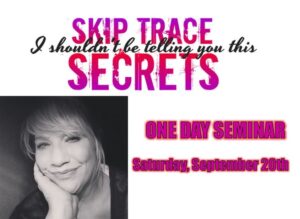 Guest Editorial
Guest Editorial
With the growing prevalence of technology and social media such as Instagram, Facebook and Twitter, many have lost the social skills or the ability to carry on a good conversation. I have seen conversation slipping away in my personal life. My son or daughter will text my wife or me while they are in the next room! Yes, you read that correctly. They will send texts asking what’s for dinner from their rooms rather than getting up and walking 30 feet to ask the question face-to-face.
As a skip-tracer, my ability to communicate and talk to people is the very essence of what I do. Extracting information from people who may not want to talk or who do not know the value of the information they have can only be effectively exploited through ordinary verbal conversation.
Nothing beats in-person face-to-face meetings, but if that is not an option, a phone call is the next best thing. Without the related reference of tone-of-voice and other verbal cues, misunderstandings are common. I can’t tell you how many times I have received an e-mail that I perceived as being combative or insulting, then picked up the phone to call the sender to have a confrontation on the issue, only to discover that it wasn’t their intent at all.
If you are relying on e-mails and texts as your main form of communication, you’re losing a potentially competitive edge in the marketplace and your skip tracing skills are likely suffering as well.
Here are five conversational tools to help you get the information that you need for skip-tracing or any other investigation.
1. BASELINE QUESTIONS Start your conversations by asking questions you already know the answer to, such as “You’re Jane’s mother, correct?” And, “You live at 123 Main Street, Correct?” The reason to start here is so that you can hear how the person responds to your questions when there is no need for deception. You’re listening for the speed, tone, and verbiage of the responses. How long is it between the question and the answer? When someone is being honest, they will react the same way almost every time. Don’t think that a longer pause is always a clue to deception. At times it is simply a human’s way of searching the brain for a memory, yet it could be a stall used to fabricate an answer. Some people are like my son. When he’s trying to be deceptive, he will talk very fast hoping he can get the conversation over quickly. He will also try to change the subject. I listen for throat clearing, a crack in the voice, or the overuse of “Um…” or “Ahhh” that tells me he doesn’t know the answer or he’s trying to make one up.
2. OPEN-ENDED QUESTIONS An open-ended question can’t be answered “yes” or “no.” It is used to explore a topic and to gather information. For example, “How was your day?” Or, “When was the last time you saw Debbie?” These questions will require a minimum of a sentence to answer. The more you engage someone in conversation, the more information they reveal. A great way to reply to any statement is, “Really? Tell me more.” People like to talk, and to be heard. It’s just human nature. Saying, “Tell me more” will open the floodgates if it is communicated at the right moment.
was your day?” Or, “When was the last time you saw Debbie?” These questions will require a minimum of a sentence to answer. The more you engage someone in conversation, the more information they reveal. A great way to reply to any statement is, “Really? Tell me more.” People like to talk, and to be heard. It’s just human nature. Saying, “Tell me more” will open the floodgates if it is communicated at the right moment.
3. BAIT QUESTIONS A bait question gets the person to explain further or to validate their actions. After my open-ended question of “When was the last time you saw Debbie?” I may be told, “Oh, gosh, it has been months.” Now the bait question: “Wow! Really? I’m a father and I cannot imagine not talking to my little girl for that long. Have the two of you always been estranged?” No one can tolerate having their parenting skills, honesty, character or faith called into question. The reply will come barreling out before thoughts get in the way. “No, we have always been close until she started dating that Johnny kid and hanging out with all his friends!” BINGO! We’re going to find out who Johnny is. This is the time to say, “Really? Tell me more. What did he do to bring her down?” Now I’m a shoulder to cry on instead of an adversary.
the last time you saw Debbie?” I may be told, “Oh, gosh, it has been months.” Now the bait question: “Wow! Really? I’m a father and I cannot imagine not talking to my little girl for that long. Have the two of you always been estranged?” No one can tolerate having their parenting skills, honesty, character or faith called into question. The reply will come barreling out before thoughts get in the way. “No, we have always been close until she started dating that Johnny kid and hanging out with all his friends!” BINGO! We’re going to find out who Johnny is. This is the time to say, “Really? Tell me more. What did he do to bring her down?” Now I’m a shoulder to cry on instead of an adversary.
4. CLOSE-ENDED QUESTIONS A close-ended question cuts right to the heart of the matter. It calls for a one-word answer such as “Yes,” “No,” “Guilty” “Innocent.” Once you have gathered all the information you need, you can go with direct, closed-ended questions such as: “Isn’t it true that you know exactly where Alex is?” When using this type of question you need to be careful not to sound combative as that will shut your conversation down completely. Use the right tone. You don’t want to get a door slammed in your face, but if it happens, this should be at the end of the conversation, not in the opening minutes.
5. USE OF SILENCE There is an old saying that silence is golden. It can be golden for you if you know how to use it. In radio or television there’s nothing worse than “dead air.” We are conditioned to expect a conversation to flow back and forth, on and on. Break that rhythm. The other person will try to fill an awkward silence. A well-timed pregnant pause occasionally will force the other party to jump in to fill the void and give away valuable information.
“dead air.” We are conditioned to expect a conversation to flow back and forth, on and on. Break that rhythm. The other person will try to fill an awkward silence. A well-timed pregnant pause occasionally will force the other party to jump in to fill the void and give away valuable information.
In summary, a skip-tracing conversation is one that you control. Begin with baseline questions to establish an understanding of how your subject responds without the need for deception, noting the pace of the response, the words that are used, and the intensity of the tone. This gives you a barometer to detect deception and a way to plan the next type of question to deploy. Move on to open-ended questions to see what you can learn. If there is reluctance, try bait questions to draw your subject out. When you’ve explored the topic, you may choose to challenge the person with a close-ended question. And at times, careful use of silence will pay off. For example, at the end of a conversation if you hesitate before saying good-by, the person may jump in with one more point that you can use.
In any personal or business communication today, it’s easy to send a text or twitter or e-mail. But now, before I send an electronic message to a friend, a client or a prospect, I consider whether a phone call would be a better solution for this subject matter. I would challenge each of you do to do the same.
When we meet on our path of life, let me know how it turns out. Nothing would make me happier than to have a nice conversation with you.
Alex Price is a nationally-recognized expert on the Art of Skip Tracing. Currently he is the Executive Vice President for MasterFiles and author of Skip Tracers National Certification Program, The Florida Records Guide, The Military Installations Guide and blogger with over 25+ years of experience in skip-tracing, collections and public speaking.
Alex Price has become a highly sought-after speaker in the auto recovery, bail enforcement and financial service industries. He combines old school skip-tracing methods with new age cyber-tracking technology to equip attendees with tools that he gained through invaluable experience. He balances the hard facts about skips with just the right amount of humor and a touch of southern charm.












Hello: Please send me some information on your book? I’m interested in learning all there is to know…
Thanks
Mandy